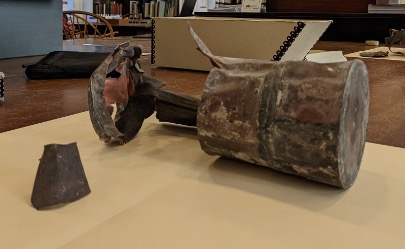From the Ground to the Cloud in 2022
On April 2013, a new oak tree was planted in place of the Lincoln Oak that Hurricane Sandy overturned the year before. The planting served as part of a celebration, which took place on the Green, of the 375th anniversary of New Haven’s founding. Several important members of the New Haven community came together to help plant the new tree, including former mayor John DeStefano, the Urban Resources Initiative, Common Ground and Sound students, and more. During the celebration, the city exhibited photos and information of the time capsule and its contents. New Haven citizens showed up to learn about the uncovered mystery and to see if their guesses about what might be held inside the capsule were correct.
The following year, the New Haven Museum curated an exhibition to commemorate the uprooting of the Lincoln Oak and the objects found beneath it. Titled “Nothing is Set in Stone: The Lincoln Oak and the New Haven Green,” the presentation ran from April 2014 to January 2015. It featured artworks by local New Haven artists, who repurposed pieces of the old Lincoln Oak tree. The Museum also included scientific information about the skeletal remains that were uncovered in the Green, as well as the items that were found in the two time capsules. Several research organizations in New Haven contributed to the curation.
Today, the New Haven Museum preserves the time capsule, though it is not publicly exhibited. Like many of the Museum’s treasures, the capsule is located at the Whitman Library, and researchers must request access to it. The objects, the time capsule, and the Abraham Lincoln sculpture made from the wood of the Lincoln Memorial Oak fallen in 2012 are all neatly cataloged and organized for anyone interested in seeing, touching, or reading any of them. But visitors need to know what they are looking for. That is where librarians come into the picture. People like Ed Surato are happy to respond to users’ needs and curiosity, open to assist with obtaining digital scans of any items or finding out further information.

But why is a time capsule that was buried in 1909 important to us today? More than anything, the historical objects it contains provide valuable insight to the history of New Haven. From the business cards to the military records in the capsule, all of these materials give us a taste of what life was like in the early 20th century. The newspaper articles feature stories that range from bills killed by the New Haven legislature to plans to celebrate the Lincoln Centennial in the city. All of these artifacts and texts come together to paint a picture of the values and traditions of New Haven from over a hundred years ago. This glimpse into the past becomes even more interesting when we compare it to contemporary New Haven. With today’s advancements in technology and more progressive social views, quite a lot has changed from the time this capsule was put together. Still, some things remain the same: one newspaper features a critique of Yale University buildings, a conversation that continues today.
Overall, the time capsule and the information surrounding it serve as educational resources for a city rich in history. Though the Museum has no further projects planned with the time capsule, we should continue to learn from it to keep expanding our knowledge of New Haven and its people.